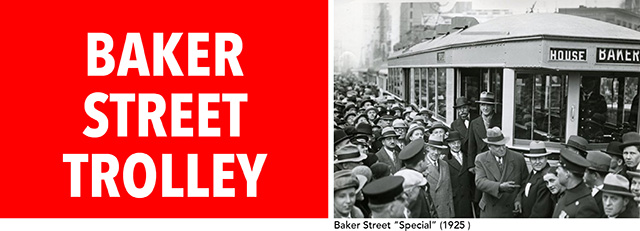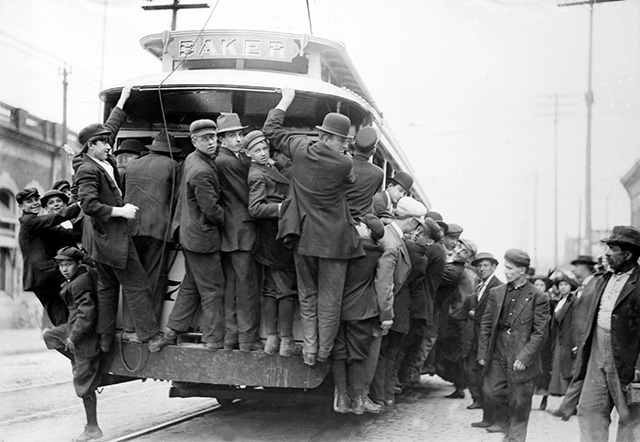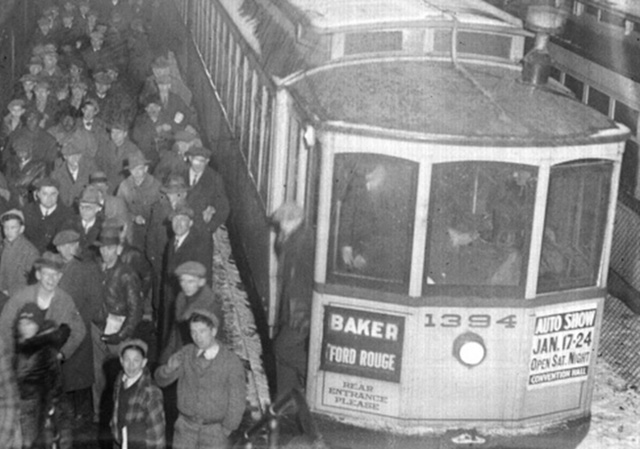
Long before Vernor Highway became the commercial backbone of Southwest Detroit, Baker Street was its main drag, and the Baker Street trolley was a major reason why. Horse drawn trolley service began on Jefferson, Woodward, Gratiot and Michigan Avenues in 1863, with the Baker line beginning in 1873, attracting development in the process. Baker Street was renamed Bagley Avenue by the early 1900s, but the transit line that rode the street kept the Baker name for several decades and the street remained important in the life of Southwest Detroit.
Coming from downtown, the original trolley ran on Congress Street, turning north on Seventh and then west along Baker to 23rd Street. The line was extended from there along Dix Avenue (today’s Vernor Highway) to LIvernois Avenue in 1886 and was electrified in 1895. It transported workers between factories, businesses, and shops along the entire flourishing commercial corridor and the growing neighborhoods flanking it.
Many Detroit workers could not afford to own a car, so the Baker Street trolley became an essential mode of transportation. With the opening of the Ford Rouge Plant in 1917, the line was extended to Dearborn, where it terminated at the Ford gates. By 1920, the line extended east to incorporate the Chene Street route. In 1928, the Baker Street trolley took over the Davison East line, ending in the far northeast section of Detroit. At that point, the line ran from the Ford Rouge plant on the west, through downtown, where it stopped at the Dodge Main plant and continued into Hamtramck, then moved east to Nevada and Van Dyke Avenues to meet the Harper line.
As the 20th century progressed, Detroit decided its public transportation future involved phasing out streetcars in favor of buses. Ford already produced transit buses, so a shift from “steel wheels to rubber tires” seemed to make sense. Beginning in 1936, the Department of Street Railways (DSR) purchased hundreds of small-size Ford buses and streetcar lines began the changeover. World War II interrupted the plan as gas rationing was imposed and workers flooded to the city for jobs. Streetcars returned to service as the city transit system struggled to find both transit workers and time to service the lines. The last DSR streetcar ran on Woodward Avenue in April 1956.
It is little wonder that given its prominent profile in Detroit’s economic life, the trolley system provoked political controversy. Some have dubbed it “Detroit’s Thirty Years War.” This 1910 account by a Detroit News reporter, traveling on the 6:15 pm westbound Baker Street trolley, boarding at Michigan and Griswold, suggests some of the challenges confronting riders:
With the inside of the car full, soon every inch on the front and rear steps were occupied by men clinging to the car. Other would-be-passengers, unable to find footing on the step,
piled on the fender and rested against the front of the car. ...They stuck to the fender and cursed the DUR [Detroit United Railway] when the motorman pleaded with them to get off.
 Circa 1925
Circa 1925
In the 1890s, prominent shoe manufacturer and Detroit Mayor Hazen Pingree concluded that the city could better operate the patchwork of privately-owned trolley lines. The public seemed inclined to agree with Pingree and his allies. In 1891, high fares and poor service sparked a riot, during which a crowd of 5,000 dumped a streetcar into the Detroit River.
In 1894, 80% of those who voted in a city advisory referendum supported municipal ownership of the trolley system. Pingree blocked the extension of franchises needed by various transit companies, which unsuccessfully sued. Then he attempted to outflank the trolley line owners by granting another set of investors the right to build a competing system that would offer a lower fare. The Mayor’s alternative plan quickly unraveled, however, as competitors moved to merge.
Pingree became Governor in 1897 and continued to champion the municipal ownership cause from the capital, Lansing. In 1899 the state legislature passed the McLeod Bill, which authorized Detroit to construct, acquire, maintain, and operate a street railway system under the control and authority of a three-person commission. The Common Council made appointments to such a commission in April 1899, naming Governor Pingree as chair.
Just as negotiations were about to open between the commission and the trolley companies, a group of prominent businessmen, including J.L. Hudson, challenged the constitutionality of the law. The nearly $17 million purchase agreement between the City of Detroit and the street railway companies was almost wrapped up when the Michigan State Supreme Court declared the McLeod Bill unconstitutional.
Between the 1890s and the successful drive for municipal control of the trolley system in the early 1920s, most candidates for alderman or mayor ran on a platform of lowering transit fares or calling outright for city ownership. On the other hand, most businessmen, including Henry Leland, were ideologically opposed to a city takeover of the trolley system. Henry Ford was a notable exception. He needed a fast and efficient way to bring workers to his huge Rouge plant, a necessity Ford had already recognized when his Highland Park facility was in full operation. Detroit residents, however, had demonstrated that they were conflicted about this issue. Despite a 1913 amendment to the city charter that made municipal ownership legal, a majority of voters turned it down in 1915.
Municipalizing transit service only became a reality after Ford Motor Company co-founder James J. Couzens was elected Mayor of Detroit in 1919. Once in office, he placed an offer to purchase the now unified transit system for $31.5 million. Couzens then proposed a radical alternative: the city would build its own municipal street railway system to put the Detroit United Railway out of business. He asked Detroiters to grant him $15 million in bonds to build and operate the new system and to purchase DUR track where the company's franchise had already expired. After waging an extensive campaign that included the production of a professionally made movie shown at neighborhood theaters, Mayor Couzens saw his proposal pass in 1920. The following year the system began to operate. Tickets were five cents with a free transfer.
DUR owners protested, of course, but once Detroit voters approved an ordinance allowing the city to force the company to remove its tracks whenever its franchise agreement expired, the DUR was willing to begin joint service on four major lines. As the city system slowly expanded, the DUR decided to sell to the city. In April 1922, voters agreed to a price of $19,850,000 along with a $4 million bond issue to cover debts.

The City of Detroit became the first large U.S. city to provide an alternative to privately owned mass transportation through municipal ownership. The Department of Street Railways at one point operated 363 miles of track, employed 4,000 workers, and utilized 1,457 streetcars and a dozen car shops.
As highway construction during the Eisenhower administration facilitated the movement of both manufacturing and people to the suburbs and beyond, Detroit lost jobs and population. In 1955, the Baker Street bus line was divided into two separate lines, with Baker Street servicing the west side and the Chene line servicing the east.
Today, fully one-third of city residents rely on public transportation. The Detroit Department of Transportation (D-DOT) has operated the city’s transit system since 1974. According to its latest schedule, the Baker Street bus—now the #1 Vernor—operates on a twenty-minute schedule during peak hours. It runs from the Rosa Parks Bus Terminal in downtown Detroit along Bagley and then out along Vernor Highway’s commercial district, the spine of the largely-Latinx Southwest Detroit community, to the Michigan/Schaefer Avenue intersection in Dearborn.
As for Baker Street, today, only a two-block strip of road with that name exists. It runs east from Cavalry Street, coming to a dead-end behind Detroit Cristo Rey High School. This small stretch of road may be all that recalls the heyday of the Baker Street trolley, though the trolley itself never ran on this street. The Vernor bus however, running just a block north of today’s Baker Street still provides vital transit service along roughly the same route as the trolley on Bagley and Vernor Avenues, through an again burgeoning Southwest Detroit.
How Detroit Might Have Built a Subway
An interesting sidelight to the acquisition of the DUR trolley lines was the 1917 recommendation from consultants hired by the Department of Street Railways Commission that the city should finance, build, and regulate the fares of a subway system, but allow the privately-owned DUR company to operate it. The money generated by the system would be equally divided between the city and the company, with the city's share being used to pay off the debt and, later, to acquire the DUR. However, consultants concluded that purchasing the DUR at that time would make it impossible for the city to also finance the building of a subway system.
Meanwhile, the plan met with the approval of the DSR Commission and in 1919 a divided Common Council passed a resolution to begin negotiations with the DUR. Mayor Couzens vetoed it. The Council attempted to override the Mayor's veto but failed by one vote.
The MotorCities National Heritage Area, the Southwest Detroit Business Association (SDBA office), and other community partners have created a series of “Wayside Signs” highlighting auto history throughout the neighborhood. You can visit the “Baker Street Trolley” sign located near the Secretary of State’s Office, just east of Central Avenue along the north side of Vernor Highway.
Click to view:
The Detroit Transit History website’s discussion of the “City Takeover” - The site also features these other summaries of interest: the “Early Years,” the “Pingree Years,” and the “DUR Years.”
“The Great Streetcar Strike of 1891” from the Michigan Labor History Society Newsletter (Spring 2019)
Text & Research - Dianne Feeley & Ron Alpern
This treatment drew on the research paper of Chad Atwood, a student in Dr. Tracy Neumann’s Wayne State University 2012 “History of Detroit” seminar.
PHOTO CREDITS
Detroit Historical Society
Baker Street “Special” (1925)
Detroit Public Library, Burton Historical Collection
Streetcar (1915)
Walter P. Reuther Library, Archives of Labor and Urban Affairs, Wayne State University
Baker Street Trolley – Ford Rouge



